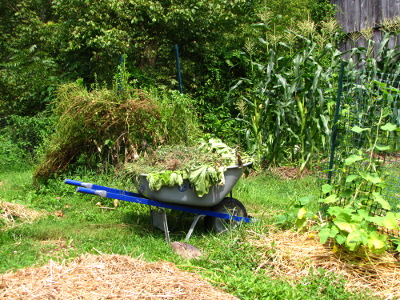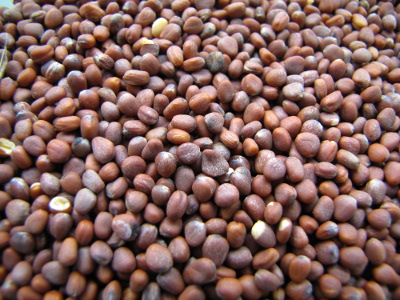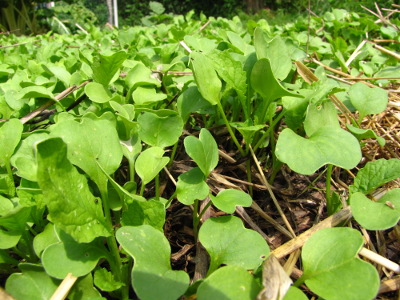
Adding organic matter with oilseed radishes
 Other than "tomato, tomato,
tomato!", the
primary topic on my to-do list this month is fall
cover crops.
I've learned that although I can seed oilseed
radishes anytime
between August 1 and September 7, every week that passes lowers the the
amount of biomass produced appreciably. That's why I wander
through the garden with an eagle eye throughout the early and middle
parts of August, looking for things to be pulled out.
Other than "tomato, tomato,
tomato!", the
primary topic on my to-do list this month is fall
cover crops.
I've learned that although I can seed oilseed
radishes anytime
between August 1 and September 7, every week that passes lowers the the
amount of biomass produced appreciably. That's why I wander
through the garden with an eagle eye throughout the early and middle
parts of August, looking for things to be pulled out.
For example, giving
away excess cucumbers
was a lot of fun in July. But by August, it seems to make more
sense to rip out still-producing cucumber plants and scatter radish
seeds in their place. Sweet corn gets cut to the ground as soon
as I pluck the least ear, and next week I'll be pulling out dead
butternut squash and watermelon vines. (I may remove some living
summer squash plants too --- we've dried our winter quota and can't eat
all of the fruits being produced.)
 I like planting fall cover
crops because they produce organic matter at an off-time for the
garden. We've got a few more beds of kale and lettuce to plant
along with a lot of garlic, but other than that, any beds that come
open from here on out are going to be sitting around twiddling their
thumbs until spring. I'd far rather put a cover crop there and
capture winter sunlight than let that solar radiation go to waste.
I like planting fall cover
crops because they produce organic matter at an off-time for the
garden. We've got a few more beds of kale and lettuce to plant
along with a lot of garlic, but other than that, any beds that come
open from here on out are going to be sitting around twiddling their
thumbs until spring. I'd far rather put a cover crop there and
capture winter sunlight than let that solar radiation go to waste.
But how much good do
cover crops do? The amount of organic matter produced by a cover
crop will depend on a lot of factors, such as your soil conditions and
planting time, but I dug up these figures for optimal dry matter
production per acre for my three favorites:
- Oilseed radish --- 7,000 pounds per acre
- Buckwheat --- 6,000 pounds per acre
- Fall-planted oats --- 4,000 pounds per acre
To put that in
perspective, adding half an inch of compost to your garden per year
requires about 68,000 pounds. Roughly half of that is water, so
the bare-minimum level of top-dressing in an organic garden provides
34,000 pounds of dry compost per acre. Cover crops don't approach
that figure, but providing a fifth of your annual organic matter with
no shoveling is nothing to sneeze at.
The big question is ---
how much of the organic matter added actually turns into humus and
stays in your soil, and how much is quickly degraded? As you may
or may not realize, the soil food web is constantly working on breaking
down organic matter, which is a good thing since the output feeds your
plants. But those microorganisms do work counter to my goal of
building soil structure.
 In fact, if you don't add
anything to your soil (especially if you till), your soil's organic
matter content will decline each year. An
interesting study showed that organic matter levels of soil increased
from 5.2% to 5.5% when 30 tons of dairy manure were applied per acre
for eleven years, stayed steady at an application rate of 20 tons per
acre, and dropped to 4.8% at 10 tons of manure per acre.
In fact, if you don't add
anything to your soil (especially if you till), your soil's organic
matter content will decline each year. An
interesting study showed that organic matter levels of soil increased
from 5.2% to 5.5% when 30 tons of dairy manure were applied per acre
for eleven years, stayed steady at an application rate of 20 tons per
acre, and dropped to 4.8% at 10 tons of manure per acre.
Meanwhile, in the cover
crop world, experts suggest that woodier
debris is more likely to turn into humus (a stable form of organic
matter) than succulent plant matter is. That's why I wait to kill
buckwheat until it's in full bloom, and why tough-stalked oats may
actually produce more long-term organic matter than oilseed radishes
do. Perhaps pulling mature oilseed radishes and composting them
would be a better way of capturing their full potential than letting
them rot in the ground?
I may try that eventually, but for now, I'm quite happy with the
ever-darkening soil in the beds that I commit to winter cover crops.
Want more in-depth information? Browse through our books.
Or explore more posts by date or by subject.
About us: Anna Hess and Mark Hamilton spent over a decade living self-sufficiently in the mountains of Virginia before moving north to start over from scratch in the foothills of Ohio. They've experimented with permaculture, no-till gardening, trailersteading, home-based microbusinesses and much more, writing about their adventures in both blogs and books.
Want to be notified when new comments are posted on this page? Click on the RSS button after you add a comment to subscribe to the comment feed, or simply check the box beside "email replies to me" while writing your comment.

I love your cover crop posts. I'm doing alot better about planting some as soon as I harvest something, and the deer are really enjoying the buckwheat I planted over the garlic I switched to daikon and oats when I harvested onions, hopefully that will do better.
I switched to daikon and oats when I harvested onions, hopefully that will do better.
You mentioned one time about writing an e-book on cover crops, is that a possible winter project?
De --- Thanks for asking about the cover crop ebook! I didn't see much interest in it when I asked on the blog, but it is one of the ones that's closest to my heart, so I may ignore my audience and just write it. I suspect it would be relatively quick and easy, unlike the chicken pasturing book I've been working on for months that keeps getting bigger and bigger and bigger so that I'm constantly further from the end....
I suspect it would be relatively quick and easy, unlike the chicken pasturing book I've been working on for months that keeps getting bigger and bigger and bigger so that I'm constantly further from the end.... 
Good luck fighting those deer!!